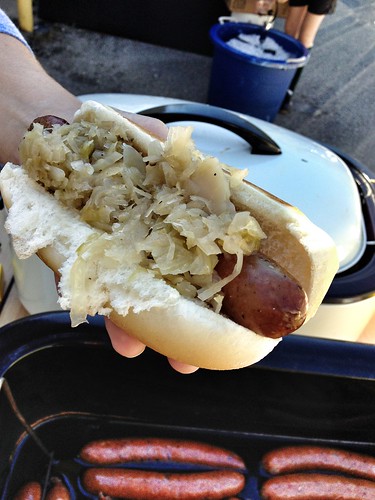If anybody out there is looking for something to do tonight at exactly 7:30 p.m., we suggest you tune in to WOTV to catch the premier of The Great American Brew Trail. It's a new television show that purports to do for the Michigan microbrewery what Diners, Drive-ins, and Dives did for the American greasy spoon, that is, to celebrate these establishments in all their glory while at the same time introducing them to potential fans who are not yet "in the know."
From what we understand, the premier episode will feature two Grand Rapids breweries, Harmony and Brewery Vivant. That's not a bad way to kick-off a series, and I for one am looking forward as much to tonight's show as I am the twelve additional episodes that will follow.
By the way, no Great American Brew Trail viewing party is complete without an assortment of new beers from your friends at Siciliano's. Here's the latest to hit the shelves.
New (and Returning) Beer
- Short's Bloody Beer, $2.19/12oz (limit 3 bottles/person) - "A lighter bodied beer with an appealing ruby red glow and aromas of spicy tomato juice. Fermented with Roma tomatoes and spiced with dill, horseradish, peppercorns, and celery seed lead to an astounding initial tomato flavor, followed by a lingering finish that allows each additional ingredient a chance to resonate on the palate. Decant carefully, and let this2009 GABF silver medal winner warm slightly in order to appreciate the full magnitude of flavors" (source).
- Coney Island Freaktoberfest, $2.69/12oz - "Arise and taken possesion of this bewitched offering of the season crafted to lure your spirit’s deepest rapture. Conjured to exorcise the grim horrors of the armies of soulless drafts everywhere" (source).
- Greenbush Sunspot Hefeweizen, $1.79/12oz - "Hot. Drenched. Delightfully blinding. Right. We're not talking about that ball of fire in the sky, but our refreshing Hefewiezen. Skip the shade and down a glass or two and be cool" (source).
- Greenbush Retribution, $2.09/12oz - "A Belgian-style ale that's good for your soul. Who says only monks get to have all of the fun? Our Belgian-Style Ale brewed with dates, raisins and brown sugar doles out a little extra soul saving because we saw what you did" (source).
- Southern Tier Imperial Oatmeal Stout, $9.29/22oz - "This beer begins in spring when oat seeds are sown as soon as the soil can be worked. Meanwhile, select types of barley are planted with hopes that Mother Nature will be kind. Our brewers wait patiently until the legumes are mature and ready for the scythe. Upon delivery to the brewery, these ingredients are mixed together in the mash tun where they steep, creating a rich molasses-like liquid. Spicy hops are boiled with the thick brew, giving balance and complexity. Brewers yeast feasts upon the rich sugars, concluding its transformation into oatmeal stout. Pour Oat into a snifter, allow its thick tan head to slowly rise, releasing unbridled aromas. The color of Oat is as dark as a moonless night. The first sip reveals Oat’s thick and nourishing taste. Like a haversack to a horse, a bottle of this stout is a meal in itself" (source).
- Leinenkugel Big Eddy Baltic Porter, $2.99/12oz - "A rich, malty brew with toffee, port, and chocolate notes and a dark fruit finish" (source).
- Epic Elder Brett Saison-Brett Golden Ale, $12.09/22oz - "Epic Brewing Company’s latest barrel-aged beer brings something new—wild yeast. This brew is a collaboration ale with Crooked Stave Artisan Brewing of Fort Collins, Colorado. Chad Yakobson, Brewmaster/Owner of Crooked Stave, is well known for his skill and knowledge in the brewing of sour and Brettanomyces driven beers. The beer was brewed at Epic by the two brewers. Kevin Crompton, Epic’s Brewmaster, and Chad spent several weeks working on the recipe and selecting the proper Brett strains and barrels for the beer to morph from a golden Saison into a Saison-Brett Golden Ale" (source).
- Schell Octoberfest, $1.49/12oz - "We’ve found the key to what makes Fall so special, and its called Octoberfest. This rich, smooth lager uses a perfect balance of caramel, pale, cara-pils and black malts to create the best Octoberfest beer of the season. Available September through October" (source).
Customer of the Week
 |
| Kyle Lenkey |
Cheers!
.JPG)


.PNG)

.JPG)





.JPG)

